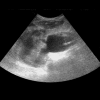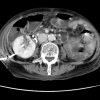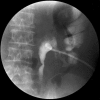Renocolic fistula secondary to a perinephric abscess: a late complication of a forgotten double J stent
- PMID: 19795000
- PMCID: PMC2752785
- DOI: 10.3346/jkms.2009.24.5.960
Renocolic fistula secondary to a perinephric abscess: a late complication of a forgotten double J stent
Abstract
Late complications of ureteral stents are frequent, and longer indwelling times are associated with an increased frequency of complications. Although there are reports of various complications of long-term indwelling ureteral stents, a renocolic fistula secondary to a perinephric abscess resulting from an indwelling ureteral stent has not been reported. Here, we present a fatal case of a renocolic fistula secondary to a perinephric abscess caused by an encrusted forgotten double J stent in a functionally solitary kidney.
Keywords: Catheters, Indwelling; Complications; Urinary Fistula.
Figures



Similar articles
-
Renocolic fistula secondary to chronic pyelonephritis.Int Urol Nephrol. 1993;25(3):229-33. Int Urol Nephrol. 1993. PMID: 8225822
-
[Renocolic fistulae].Osp Ital Chir. 1969 Mar;20(3):273-80. Osp Ital Chir. 1969. PMID: 5396746 Italian. No abstract available.
-
[Renocolic fistula on an atrophic kidney caused by suppurative pyelonephritis].J Urol Nephrol (Paris). 1972 Jan-Feb;78(1):109-12. J Urol Nephrol (Paris). 1972. PMID: 5054889 French. No abstract available.
-
[Renocolic fistula caused by xanthogranulomatous pyelonephritis: a case report].Hinyokika Kiyo. 1990 Jan;36(1):63-7. Hinyokika Kiyo. 1990. PMID: 2408266 Review. Japanese.
-
Renocolic fistula as a complication of radiofrequency in the treatment of renal cell carcinoma.Arch Esp Urol. 2010 Jan-Feb;63(1):74-7. Arch Esp Urol. 2010. PMID: 20157223 Review.
Cited by
-
Enterorenal Fistula as an Unusual Complication from Ureteroscopic Lithotripsy: A Case Report.J Endourol Case Rep. 2019 May 30;5(2):49-52. doi: 10.1089/cren.2018.0102. eCollection 2019. J Endourol Case Rep. 2019. PMID: 31179384 Free PMC article.
-
Renocolic fistula secondary to urothelial carcinoma.BMJ Case Rep. 2018 Mar 9;2018:bcr2017223558. doi: 10.1136/bcr-2017-223558. BMJ Case Rep. 2018. PMID: 29525757 Free PMC article.
References
-
- Richter S, Ringel A, Shalev M, Nissenkorn I. The indwelling ureteric stent: a 'friendly' procedure with unfriendly high morbidity. BJU Int. 2000;85:408–411. - PubMed
-
- Paick SH, Park HK, Oh SJ, Kim HH, Kim SW. Characteristics of bacterial colonization and urinary tract infection after double-J ureteral stent indwelling. Korean J Urol. 2002;43:291–295. - PubMed
-
- Damiano R, Oliva A, Esposito C, De Sio M, Autorino R, D'Armiento M. Early and late complications of double pigtail ureteral stent. Urol Int. 2002;69:136–140. - PubMed
-
- Singh V, Srinivastava A, Kapoor R, Kumar A. Can the complicated forgotten indwelling ureteric stents be lethal? Int Urol Nephrol. 2005;37:541–546. - PubMed
-
- Chung SY, Stein RJ, Landsittel D, Davies BJ, Cuellar DC, Hrebinko RL, Tarin T, Averch TD. 15-year experience with the management of extrinsic ureteral obstruction with indwelling ureteral stents. J Urol. 2004;172:592–595. - PubMed
Publication types
MeSH terms
LinkOut - more resources
Full Text Sources
Medical

